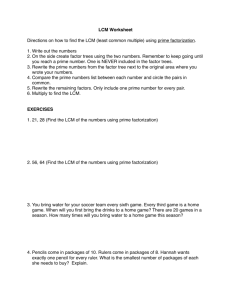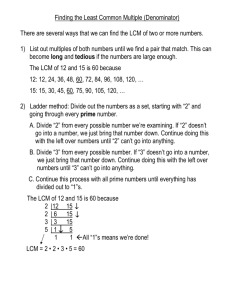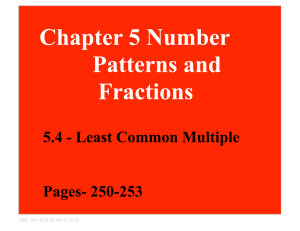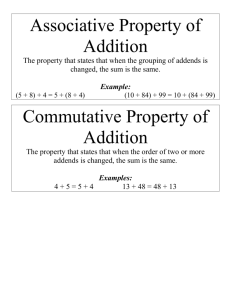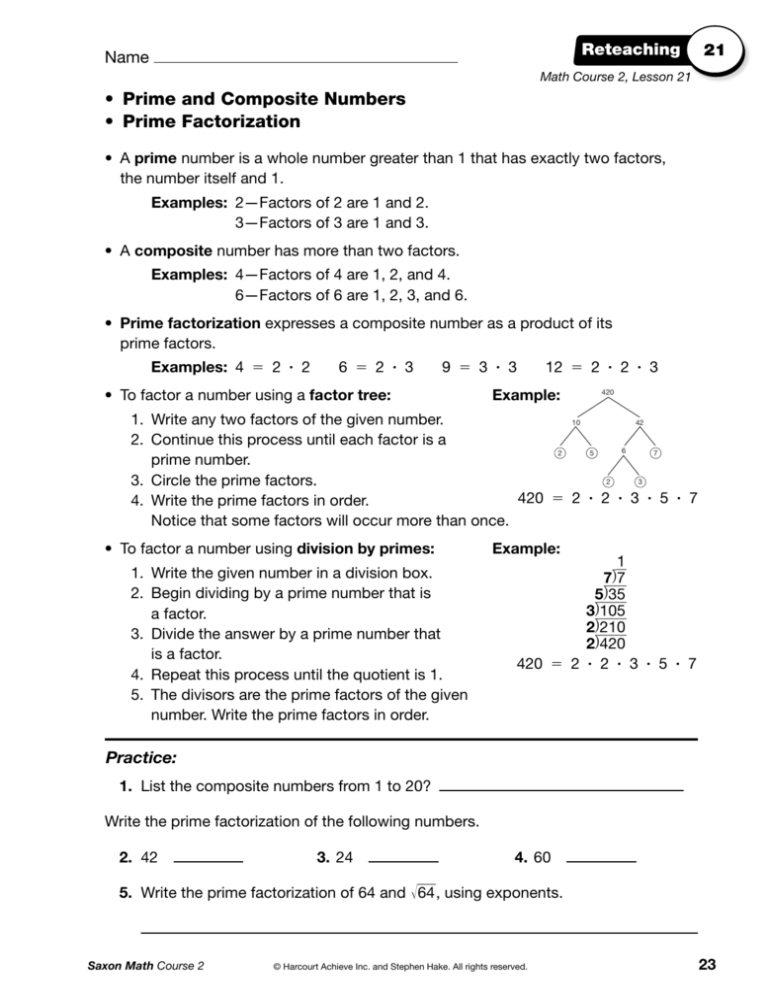
Reteaching
Name
21
Math Course 2, Lesson 21
• Prime and Composite Numbers
• Prime Factorization
• A prime number is a whole number greater than 1 that has exactly two factors,
the number itself and 1.
Examples: 2—Factors of 2 are 1 and 2.
3—Factors of 3 are 1 and 3.
• A composite number has more than two factors.
Examples: 4—Factors of 4 are 1, 2, and 4.
6—Factors of 6 are 1, 2, 3, and 6.
• Prime factorization expresses a composite number as a product of its
prime factors.
Examples: 4 = 2 ∙ 2
6 = 2 ∙ 3
9 = 3 ∙ 3
• To factor a number using a factor tree:
12 = 2 ∙ 2 ∙ 3
Example:
420
1. Write any two factors of the given number.
10
42
2. Continue this process until each factor is a
6
2
5
7
prime number.
2
3
3. Circle the prime factors.
420 = 2 ∙ 2 ∙ 3 ∙ 5 ∙ 7
4. Write the prime factors in order.
Notice that some factors will occur more than once.
• To factor a number using division by primes:
1. Write the given number in a division box.
2. Begin dividing by a prime number that is
a factor.
3. Divide the answer by a prime number that
is a factor.
4. Repeat this process until the quotient is 1.
5. The divisors are the prime factors of the given
number. Write the prime factors in order.
Example:
1
__
)7
7___
) 35
5____
3)____
105
2)____
210
2) 420
420 = 2 ∙ 2 ∙ 3 ∙ 5 ∙ 7
Practice:
1. List the composite numbers from 1 to 20?
Write the prime factorization of the following numbers.
2. 42
3. 24
4. 60
___
5. Write the prime factorization of 64 and √ 64 , using exponents.
Saxon Math Course 2
© Harcourt Achieve Inc. and Stephen Hake. All rights reserved.
23
Reteaching
Name
22
Math Course 2, Lesson 22
• Problems About a Fraction of a Group
• To solve problems about a fraction of a group use diagrams.
Example: Debbie scored __23 of her team’s 36 points.
How many points did she score?
1. Draw a rectangle. This stands for
the total.
36 points
2. Divide the rectangle into the same
number of parts as the denominator.
The denominator of __23 is 3, so divide
the rectangle into 3 equal parts.
36 points
3. Divide the total by the denominator.
36 ÷ 3 = 12
Write that answer in each part.
36 points
12 points
12 points
12 points
4. Bracket the parts into fractions.
Debbie scored 24 points.
36 points
12 points
12 points
12 points
2
— Debbie
3
1
— Team
3
scored
scored
Practice:
Draw a diagram of each statement. Then answer the questions that follow.
Fifty people saw the movie. Two fifths were children.
50 people
10 people
1. How many children saw the movie?
10 people
2
— children
5
10 people
2. How many adults saw the movie?
Twenty-five percent of the 12 books were mysteries.
10 people
10 people
12 books
3 books
3. What fraction of the books were not mysteries?
3
— adults
5
1
— mystery
4
books
3 books
3 books
3
— non-mystery
4
books
3 books
4. How many books were mysteries?
24
© Harcourt Achieve Inc. and Stephen Hake. All rights reserved.
Saxon Math Course 2
Reteaching
Name
23
Math Course 2, Lesson 23
• Subtracting Mixed Numbers with Regrouping
• To subtract mixed numbers that require regrouping:
1.
2.
3.
4.
Borrow 1 from the whole number and rename as a fraction.
Combine the top fraction with the renamed 1.
Then subtract.
Reduce if possible.
6
1
5 + __
1
2 __
3 __
2 + __
Example:
5
5
5
5
2
2
– 1 __
– 1 __
5
5
4
1 __
5
Practice:
Simplify 1–6.
1. 6 – 2 __58
2. 4 __13 – 3 __23
3. 50% – 12 __12 %
4. 25 __16 % – 5 __56%
5. 27 __17 – 13 __57
6. 100% – 73 __34 %
Saxon Math Course 2
© Harcourt Achieve Inc. and Stephen Hake. All rights reserved.
25
Reteaching
Name
24
Math Course 2, Lesson 24
• Reducing Fractions, Part 2
• Reduce large numbers by prime factorization.
Cancel matching factors.
2 ∙ 3∕ ∙ 7∕
2 ∙ 3 ∙ 7
42 = _________
2
_________
Example: ____
= __
5
105
3 ∙ 5 ∙ 7
3 ∙ 5 ∙ 7
• Cancel means “reduce before multiplying.”
3 × __
2
__
8
3
Pair any numerator
with any denominator.
1
1
8
3
3∕
2∕
1
__
× __
= __
4
1
4
Cancel. (Reduce the pairs.)
Multiply the reduced terms.
• Another way to find the greatest common factor (GCF) of two numbers:
1. Write the prime factorization of each number.
2. Circle the common factors.
3. Multiply these common factors to find the GCF.
Example: Find the GCF of 24 and 64.
24 = 2 ∙ 2 ∙ 2 ∙ 3
64 = 2 ∙ 2 ∙ 2 ∙ 2 ∙ 2 ∙ 2
GCF = 2 ∙ 2 ∙ 2 = 8
Practice:
Reduce 1–3.
72
1. __
84
55
2. ___
150
39
3. ___
169
Simplify 4 and 5.
3
4. __25 ∙ __78 ∙ __
14
12
5. __56 ∙ __34 ∙ __
15
26
© Harcourt Achieve Inc. and Stephen Hake. All rights reserved.
Saxon Math Course 2
Reteaching
Name
25
Math Course 2, Lesson 25
• Dividing Fractions
• The reciprocal of any whole number or fraction is the reverse of terms. The product
of a term and its reciprocal is 1.
Examples: The reciprocal of 3 is __13 .
The reciprocal of __13 is 3, or __31.
The reciprocal of __56 is __65.
• To divide whole numbers sometimes multiply by the reciprocal of the divisor.
8
Example:
24
3 = ___
24 ÷ __
1 = 8
24 ÷ 3 = ___
× __
1
1
1
3
1
• To divide fractions, multiply by the reciprocal of the divisor.
1
Example:
3∕
2 ÷ __
1 = __
2 × __
__
= 2
3
3
3
1
1
1. Copy the first number (fraction).
1
2 ÷ __
__
2. Change ÷ to ×.
3
3. Write the reciprocal of the second fraction.
4. Cancel (reduce pairs) if possible.
3
1
3∕
2 × __
__
= 2
3
1
1
5. Multiply.
Practice:
Simplify 1–6.
3
1. __
÷ __18
16
7
2. __15 ÷ __
10
3
3. __23 ÷ __4
4. 12 ÷ __16
8
5. __
÷ __13
15
12
6. __67 ÷ __
14
Saxon Math Course 2
© Harcourt Achieve Inc. and Stephen Hake. All rights reserved.
27
Reteaching
Name
26
Math Course 2, Lesson 26
• Multiplying and Dividing Mixed Numbers
• To multiply and divide mixed numbers:
1. Change mixed numbers to improper (“top heavy”) fractions.
2. Then multiply or divide.
3. Simplify (reduce and/or convert) as necessary.
Examples:
Multiply
1 × 1 __
2
2 __
2
3
3
5 × __
5
__
2
Divide
1 ÷ 2 __
1
3 __
Change mixed
numbers to improper
fractions.
3
2
5
10 ÷ __
___
3
Change mixed
numbers to improper
fractions.
2
2
5 × __
5 = ___
25 Multiply.
__
2
3
6
10
2 = __
4
___ × __
3
3
5
1
1 Simplify.
= 4 __
6
Multiply by reciprocal of
the divisor.
1 Simplify.
= 1 __
3
Practice:
Simplify 1–6:
28
1. 4 __12 × __13
2. 1 __14 ∙ 7 __35 ∙ 2 __12
3. 6 × 4 __14
4. 1 __58 ÷ 4
5. 8 __16 ÷ 2 __13
6. 5 ÷ __15
© Harcourt Achieve Inc. and Stephen Hake. All rights reserved.
Saxon Math Course 2
Reteaching
Name
27
Math Course 2, Lesson 27
• Multiples
• Least Common Multiple
• Equivalent Division Problems
• Use times table in Reference Guide to find the least common multiple (LCM) of
small numbers.
Example: Find the LCM of 6 and 8.
Look down the 6’s and the 8’s columns.
Find the first number that is the same in both columns.
LCM = 24
• Use prime factorization to find the LCM of larger numbers.
Example: Find the LCM of 54 and 60.
1. Factor each number into prime factors.
54 = 2 ∙ 3 ∙ 3 ∙ 3
60 = 2 ∙ 2 ∙ 3 ∙ 5
2. Write each prime factor the greatest number of times it was used
to form either number.
2 ∙ 2 ∙ 3 ∙ 3 ∙ 3 ∙ 5
3. Multiply these factors to find the LCM.
LCM = 2 ∙ 2 ∙ 3 ∙ 3 ∙ 3 ∙ 5 = 540
• Use equivalent division to make complicated problems easier. Cancel
matching zeros.
Multiply or divide the dividend and divisor by the same number to form a new
problem that is easier to calculate.
220
Example: ____
5
Multiply both numbers by 2 to form an equivalent problem.
440∕
220 × __
2 = ____
____
= 44
5
2
10
Practice:
Find the least common multiple (LCM) of each pair or group of numbers.
1. 14 and 20
2. 21 and 33
3. 3, 7, and 10
4. 2, 6, and 8
5. 24 and 60
6. 36 and 63
Saxon Math Course 2
© Harcourt Achieve Inc. and Stephen Hake. All rights reserved.
29
Reteaching
Name
28
Math Course 2, Lesson 28
• Two-Step Word Problems
• Average, Part 1
• Two-step word problems can be written as two-step computation problems.
Example: 10 – (6 + 3)
Parentheses can make the problem easier.
Example: Julie went to the store with $20. She bought 8 cans of dog food for
67¢ per can. How much money did she have left?
$20 – (0.67 × 8)
1. Find out how much she spent.
0.67 × 8 = $5.36
2. Then find out how much money she had left.
$20 – $5.36 = $14.64
• Calculating an average is often a two-step process.
1. Add the items.
2. Divide by the number of items.
The answer must be between the smallest and the largest numbers.
Another name for average is mean.
Example: There were 3 people in the first row, 7 in the second row, and 20 in
the third row. What was the average number of people in each of
the rows?
3 people
7 people
10 people per row
+ 20 people
30 people
__________
3 rows) 30 people
• The average of two numbers is the number halfway between the given numbers.
Practice:
1. Hilda’s scores on five games were the following:
83, 89, 94, 99, and 100. What was her average score?
2. Myrna bought 7 pounds of meat for a barbecue.
She paid $2.49 per pound and gave the clerk a
$20 bill. How much change should she receive?
3. Jim drove 175 miles in 3 hours 30 minutes.
How many miles per hour did Jim drive?
4. What is the average (mean) of 250 and 450?
30
© Harcourt Achieve Inc. and Stephen Hake. All rights reserved.
Saxon Math Course 2
Reteaching
Name
29
Math Course 2, Lesson 29
• Rounding Whole Numbers
• Rounding Mixed Numbers
• Estimating Answers
Before working a problem, estimate by rounding the numbers first.
• To round whole numbers:
1. Circle the place value you are rounding to.
2. Underline the digit to its right.
3. Ask “Is the underlined number 5 or more?”
Yes
Add 1 to the circled number.
No
Circled number stays the same.
4. Replace the underlined number (and any numbers after it) with zero.
Examples:
6 7
3 28
70
300
• To round mixed numbers, compare each fraction to __12 .
If the fraction is equal to or greater than __12 , round up to the next whole number.
If the fraction is less than __12 , round down.
2
2 > __
1
Examples: 6 __
7 because __
3
3
2
1
1
__
__
__
6
6 because < 1
8
8
2
(
(
)
)
Practice:
1. Round 12,253 to the nearest thousand.
2. Round 27,390 to the nearest hundred.
3. Estimate the quotient when 73,280 is divided by 70.
4. Estimate the sum of 14 __25 and 10 __12.
Saxon Math Course 2
© Harcourt Achieve Inc. and Stephen Hake. All rights reserved.
31
Reteaching
Name
30
Math Course 2, Lesson 30
• Common Denominators
• Adding and Subtracting Fractions with Different Denominators
• To add or subtract fractions with different denominators:
1. Find the least common multiple (LCM) of the denominators.
If the denominators are small numbers, use the times table.
Look down the columns of each denominator.
The first number that is the same in both columns is the LCM.
If the denominators are large numbers, use prime factorization.
Factor each denominator into prime factors.
Write each prime factor the greatest number of times it was used to form
either number.
Multiply these factors to find the LCM.
2. Rename the fractions using the LCM as the new common denominator.
3. Add or subtract.
4. Simplify.
3
1 = 3 __
3 __
Example:
2
6
1 = 1 __
1
+ 1 __
6
6
2
__
4 4 = 4 __
3
6
Practice:
1. Rewrite __47 and __35 so they have
common denominators.
Then find the sum and simplify.
Simplify 2–4.
32
1
2. 1 __
+ 5 __34 + 3 __25
10
2
3. 3 __45 – 1 __
10
4. __35 ∙ __16 + __14
5. Compare: __13
○
© Harcourt Achieve Inc. and Stephen Hake. All rights reserved.
2
__
5
Saxon Math Course 2


